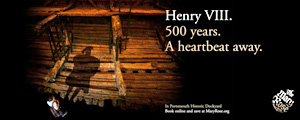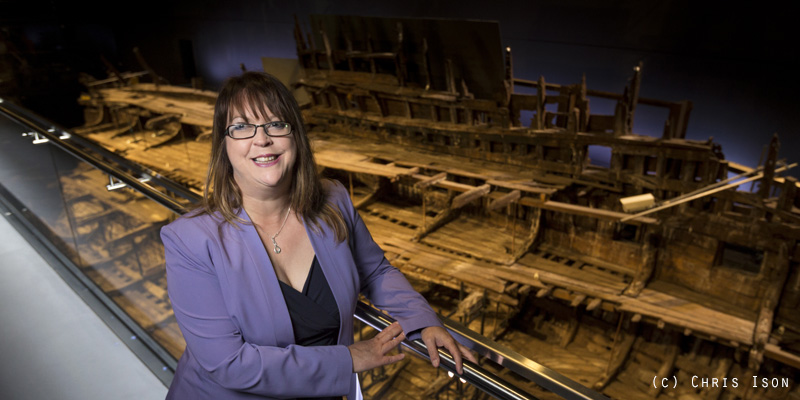Helen Bonser-Wilton is chief executive of the Mary Rose Trust. The Mary Rose offers a unique and immersive journey into Tudor Life, Henry VIII’s flagship and the 19,000 personal and professional Tudor artefacts that were excavated from the seabed and are now displayed in a state-of-the-art Museum in Portsmouth.

“…the iconic and unique nature of Mary Rose means that we aim to be spoken of in the same breath as Stonehenge, the Roman Baths and the Tower of London…”
My career to date
I qualified as an interpreter and used my languages to move into advertising, then marketing for Crown Paint. In 2003 I decided to move to Devon and joined the National Trust as Marketing and Supporter Development Manager, then moved to be programme director for Tyntesfield, the National Trust’s biggest ever project.
I then became operations director for the South West, ran the Trust’s 2010 Change Programme and moved to be CEO of the Mary Rose Trust in September 2015.
A must-experience British icon
My role is a fascinating mix of external partnerships, fundraising, leadership of our team of staff and volunteers and developing strategy and future projects to fulfil the Trust’s mission in the 21st century.
After delivering our previous strategy, ‘to create a sensational and sustainable museum for the Mary Rose and her unique collection’, we needed something equally ambitious. We decided on ‘To become a must-experience British icon’ – the iconic and unique nature of Mary Rose means that we aim to be spoken of in the same breath as Stonehenge, the Roman Baths and the Tower of London.
How the Trust operates
We have around 48 full time equivalent staff and 130 volunteers who deliver learning workshops, digitise our archive and importantly, welcome and inspire our hundreds of thousands of visitors every year. As CEO, I report to a board of volunteer trustees, from all walks of professional life, including archaeology, history, finance and education. Some of our trustees include Dr. David Starkey and Professor Barry Cunliffe, eminent historian and archaeologist respectively.
History of the Mary Rose
The Mary Rose was commissioned by Henry VIII when he came to the throne aged 17 in 1509 and sailed throughout his reign. She saw him through five and a half wives and eventually sank while countering a French invasion force larger than the Spanish Armada in Portsmouth in 1545.
Rediscovered in 1971, excavated throughout the 1970s with the help of 500 volunteers, doing 28,000 hours of dives and eventually raised from the Solent in 1982, the Mary Rose is displayed in Portsmouth Historic Dockyard.
On #InternationalWomensDay I remember Margaret Rule, the driving force behind @MaryRoseMuseum excavation & raising. pic.twitter.com/k9vuXhdRcW
— Helen Bonser-Wilton (@MaryRose_CEO) March 8, 2018
Housed for 30 years within a tent, the ship was sprayed with chilled water for 12 years to prevent her drying out before moving to a regime of spraying with chemical wax for 19 years, to ensure that her degraded timber cells were strengthened. Control air dried in 2013-16, she resides within a purpose-built museum that opened in 2013.
Her unique collection tells a compelling story about life in Tudor times at all levels of society and showcases the sights, sounds and smells of Tudor Times, including through state of the art projections of the crew moving about on board.
Iron awe!
1,200 iron cannonballs were excavated from Mary Rose and it is fair to say that seawater and iron are not comfortable bedfellows.
Corrosion has occurred on some conserved cannonballs and as part of a piece of research to understand relative benefits of different conservation treatments, we have used the latest X-ray equipment through Diamond Light Source [the UK’s national synchrotron science facility, located at the Harwell Science and Innovation Campus in Oxfordshire] to understand the molecular structure of cannonballs that have been conserved in different ways.
How to preserve the 1,248 cannonballs found on the Mary Rose warship – Diamond is delighted to have worked as part of a collaboration to shed light on the effectiveness of different conservation techniques. https://t.co/q0d07yjtWJ pic.twitter.com/wyCyHBzd9M
— Diamond Light Source (@DiamondLightSou) March 9, 2018
Our intention is to find the best way of conserving these important artefacts for future generations.
Taking care of a national icon
The challenge for any heritage organisation is to raise enough money to care for their assets and to enable access by the public. Since we are looking to do this in perpetuity, it becomes quite expensive, especially when you have a vast collection of fragile Tudor artefacts.
The real costs of care for the collection are behind the scenes – the museum is run by a wide range of sophisticated environmentally controlled artefact cases, which are supported through a complex system of chillers, air handling units and heating, to ensure that the temperature and relative humidity is kept at the right level for the various materials that we are caring for.
The Ship Hall itself is vast and carefully environmentally controlled to ensure that Mary Rose survives for future generations to enjoy. The environmental systems which keep the collection in good condition necessitate high levels of spending on energy, as well as regular equipment maintenance and replacement.
As a national icon, which receives no Government support, the financial challenges of keeping the collection in good shape remain challenging.
How Womanthology readers can get involved
We would love to welcome you to visit – book online on www.maryrose.org. We will also shortly be launching two supporter schemes, a membership costing around £90 p.a. and an ‘Adopt an Artefact’ scheme, where you can support your favourite object. Keep an eye on our website for updates. And as a charity that relies entirely on ticket income and fundraising to care for our collection, we are always delighted to welcome donations!
Coming up next

This year we are also running major events programmes, featuring the Tudor Galley being fired up and cooked on, Tudor pastimes and costumes, as well as a participative LEGO brick programme at May half term and over summer, where you book to build a square of a giant LEGO brick mosaic. For the future, we are looking at developing a temporary exhibition space so we can refresh the offer and bring in great exhibitions to tell more of our Tudor story.
As for me, I have plenty to do to deliver all of this and no plans to move on for a while!
https://twitter.com/MaryRoseMuseum
https://twitter.com/maryrose_ceo
https://www.facebook.com/MaryRoseMuseum/
Main image credit: By James Basire after Unknown (1520/1550) [Public domain], via Wikimedia Commons





